#keita takahashi
Text
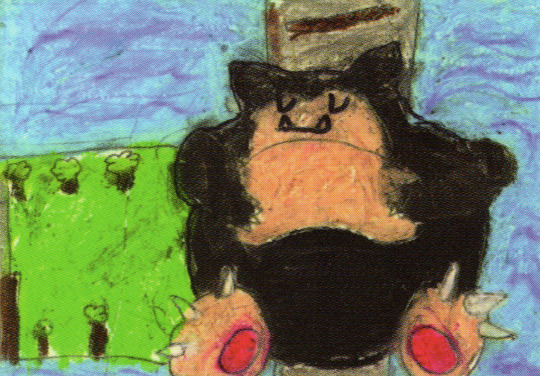
Snorlax -- Keita Takahashi
#snorlax#kanto#keita takahashi#NOT THE FAMOUS ONE I PROMISE#NOT THE KATAMARI GUY THIS IS DEFINITELY A CHILD
3K notes
·
View notes
Text

lonely ballin star
804 notes
·
View notes
Text
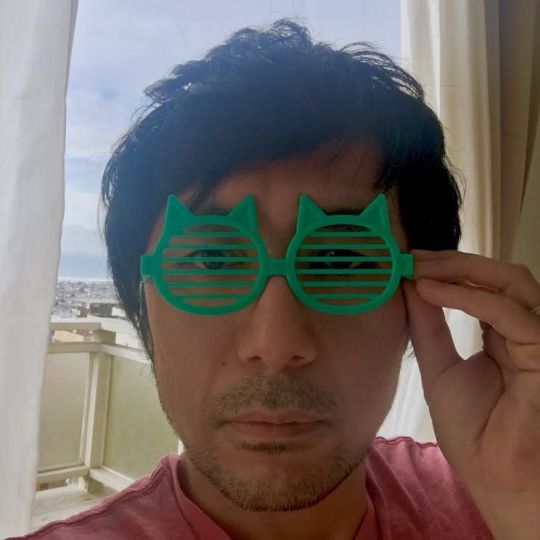


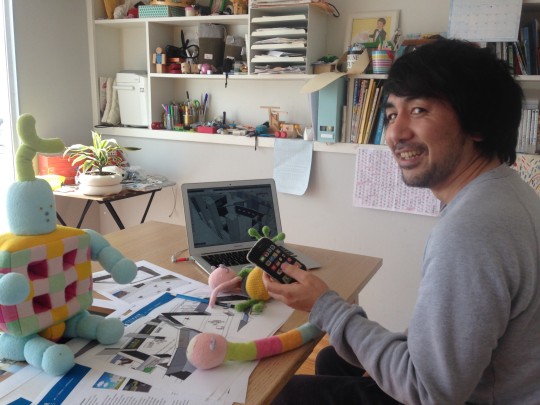
creator of katamari damacy, keita takahashi
#katamari#the prince of all cosmos#we love katamari#katamari damacy#katamari forever#katamari posting#keita Takahashi
47 notes
·
View notes
Text










Very cute Noby Noby Boy icons ripped by me
67 notes
·
View notes
Text
hi please check out "katamari george", a song that I wrote while having a very keen interest in pharmaceutical stimulants
122 notes
·
View notes
Text
Reveal trailer for "to a T," a game by Keita Takahashi and Uvula LLC.
#video#to a T#keita takahashi#am i posting this because i havent seen anyone talk about it? maybe...#am i posting it because i rly like the song here and want to listen to it on my blog? maybe....
80 notes
·
View notes
Photo

Katamari Damacy REROLL • 2018
129 notes
·
View notes
Text

Doodle this doggo yesterday from a game called To a T!
tell me your thoughts
25 notes
·
View notes
Text
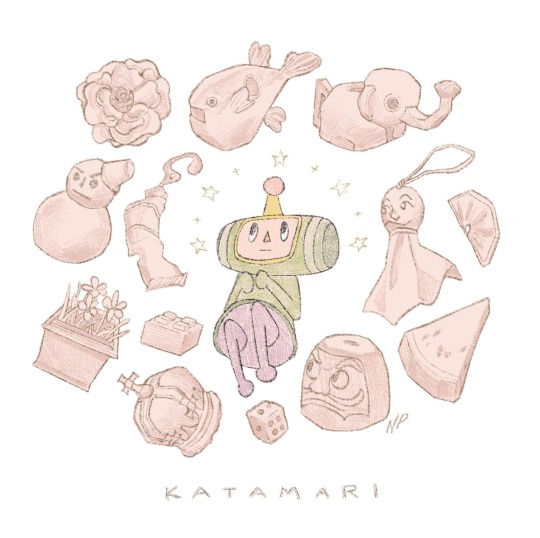
the prince
91 notes
·
View notes
Text
“Surreal characters, simple controls and a catchy soundtrack turned the 2004 PlayStation 2 title into a masterpiece. Last month its sequel, We Love Katamari, which arguably perfected those qualities, was rereleased with improved graphics and new levels.
But Takahashi ended his involvement with the franchise and its publisher, Bandai Namco, long ago. He continues to live in the shadow of the katamari, experiencing the strange conditions of an industry where artistic creations become valuable intellectual property for companies. He says he does not receive any royalties from the sales of Katamari games.
“That is the nature of the business,” Takahashi said. “I am not important. The game is important. But myself? Who cares?”
Takahashi, 48, never intended to become a game designer; he originally trained as a sculptor at Musashino Art University in Tokyo. However, the young artist became disillusioned as classmates disposed of their creations after each assignment. “I realized that making art was not exactly useful,” he said.
That is why when a professor asked him to create a goat sculpture, he decided to turn the animal into a flower pot that drained excess water from its udders.
“I cannot forget that moment when everyone started laughing,” Takahashi recalled from his office in the garage of the San Francisco home where he lives with his wife, Asuka Sakai, a composer, and their two children. “That was when I realized what I should do, and I believed video games could provide joy and fun to people.”
(…)
A demo at the 2003 Game Developers Conference in San Jose caught the attention of industry leaders at a time when the market was mostly focused on multiplayer shooters like Medal of Honor and Halo. Here was something new and unusual for American audiences, invariably described as a “dung beetle” game or a “snowball simulator.”
(…)
“It feels like Katamari Damacy escaped Japan by accident,” said Paul Galloway, a collection specialist at the Museum of Modern Art who helped establish its video game program, which includes Takahashi’s debut. He added that “it presages a lot of aesthetics found during the 2010 indie gamer boom.”
(…)
But by 2009, Takahashi announced he was leaving video games, saying he would help design a playground in England.
“He is a very singular creator,” said Laura E. Hall, a game designer based in Portland, Ore., who wrote a book about Katamari Damacy. “And that is often at odds with the need to move units in the video game industry.”
Takahashi was coming off the self-described “beautiful failure” of a project called Noby Noby Boy, the one with the alien caterpillar, which received tepid reviews and had lackluster sales. The playground was also doomed; city commissioners were not too keen on the designer’s circular doughnut slide or the giant climbing frame that seemed to extend five stories in the air.
He returned to the gaming industry, but this time wanted more control over the creative process. He had left Bandai Namco because he did not think its other engineers were passionate enough.
“They were making games for the money,” he said. “And if I wanted to make a new project, I would need to hire staff from the company, which was super limiting.”
(…)
By the time Takahashi released Wattam, featuring the green cube, in 2019, Bandai Namco was already remastering his katamari games without his input.
(…)
Galloway said it was normal in the gaming industry, as in other design fields, that individual creators don’t own their creations. After all, games are a collaborative art form, typically requiring dozens of people to make.
“Someone can take Katamari and do something wildly different,” Galloway said. “But there is something that can be lost. Keita’s unique vision for Katamari was lightning in a bottle, and after a while it becomes a bit diluted when you milk the same formula over and over again.”
Takahashi does not want to repeat himself. “Recently, I realized that I don’t really know what a video game is,” he said, explaining his attempts to shed his preconceptions about what defines a good game.
His new definition is much simpler: Bring joy back into people’s lives.
(…)
“I know our lives are not so fun. They are boring. We do the same things over and over,” Takahashi said. “But we should be celebrating the good things in life. Then we can become better people. That’s my thing right now.””
“Katamari Damacy is a special sort of game. So special in fact, that it sidetracked me from writing this several times, playing the game in an absent-minded daze, marvelling at how 塊,the Kanji for katamari, already looks like a small prince rolling stuff up. It worms itself inside your brain by giving the mundane a unique sort of whimsy.
Whimsy, silliness and fun on first glance seem like something unrestrained and purposefully difficult to capture, but Katamari's game director Keita Takahashi made these feelings into substantial pillars of the design philosophy that informs all of his games. Katamari is meant to convey novelty, ease of understanding, enjoyment, and humour, all in a neat little package.
(…)
Yet most of the motivation comes from how you receive encouragement much more frequently than punishment. You're not told to hurry, all items you pick up are equally valid to build your clump with. The consequences of bumping into something are never catastrophic. The King of all Cosmos often reacts enthusiastically to your efforts and the nature of the things you roll up, which is understandable, given I'm generally just as overjoyed whenever I find a spare pound between the couch cushions. The wrath of your father the king is severe, but easily soothed by success. The knowledge that it was his drunken debauchery that nearly caused the collapse of the entire cosmos in the first place makes it difficult to take him seriously in his anger. This way, the king is a quintessential dad - a stern, occasionally threatening force on one hand, the guy who falls asleep with his mouth open at a rerun of "I'm a celebrity" on the other. (I'm absolutely not drawing on personal experience here.)
Narratively, Katamari could make a dire point about the dangers of consumerism and the fact that there really is quite a lot of stuff on earth, but as with every other aspect, it's lenient and careful not to hamper your enjoyment. There is a joy in collecting, after all, preserved all the way from collecting shells from the beach, shiny buttons or stickers as children. Why not virtual thumbtacks and cucumbers?
Nothing about Katamari Damacy would work quite as well, however, if it weren't for its laid-back visual aesthetic. With his background in art, Keita Takahashi isn't so much interested in games as he is in playfulness. You can immediately see influences like Taro Okamoto or Yayoi Kusama in the way he uses colours and shapes.
(…)
By not taking itself too seriously, Katamari allows you to do something that may not serve a distinct purpose. It invites you to look at something visually pleasing and hum a happy tune, to unite what by all accounts shouldn't be united into a satisfying shape. Takahashi's games are different to us because we already have an idea in our minds of how games work, how fun is facilitated and how you maximise engagement. Takahashi found his own answers to all of these questions and instead drew on ideas that are equally familiar to his players from other aspects of life.
Katamari Damacy is designed to appear mostly unconcerned with design, at least the right kind of design. Instead, it's something that simply feels good, and that feeling never goes out of style.”
“Katamari Damacy achieves all of its emotional weight without any complex story or characters, without surmounting any gameplay challenges. This simple game only occasionally deviates from your goal of making your Katamari as large as possible under a time limit.
(…)
Just like any mythology, this simple plot and characters themselves express a deeper network of meanings and associations. In Steven Reale’s Chaos in the Cosmos: The Play of Contradictions in the Music of Katamari Damacy, he notes that the King often dashes the Prince’s attempts to live up to his approval throughout the game. The King towers over the tiny Prince, and even when a level is successfully completed, the King still asks that next time, “we want a bigger one” (Reale, 2011). At its heart, Reale suggests the story of Katamari is that of the frustrations of childhood.
(…)
Katamari Damacy was often referenced by game content producers on YouTube, and its praise by some of my favourite reviewers is what initially piqued my interest. It was through the nostalgic lens that drives so many classic game enthusiasts that I learned an important lesson: the games that I played during these developmental years will have an unrivaled amount of cultivated memories associated with them. More importantly, this is worth celebrating and sharing with others.
(…)
Katamari Damacy captured everything that made childhood special, and more precisely, why it was so joyous to reclaim “play time” all to the tune of “Cherry Blossom Color Season”, one of the most powerful and serene tracks on the soundtrack. The game’s composer, Yuu Miyake even cited it as his favourite song from the whole series, a simple but powerful showcase of his ability to compose a song only with simple chords and melody (Napolitano, 2009).
The moment was pure bliss. I have never felt so completely and holistically happy playing a game, and I think Katamari Damacy achieves this moment by virtue of its simplicity, which consistently evokes a sense of childhood, imagination and free play. Miyake’s simple song was coupled with straightforward gameplay and tactile controls. Together, these elements created the sense of pure joy and discovery that comes with exploring levels and discovering hundreds of new objects.
(…)
In a 2009 Game Developers Conference talk, Takahashi confirmed that Katamari Damacy was about consumption society. This presented a problem: his goal to make things light-hearted, silly, and fun was wrapped up in work that expressed a cynical stance towards society. He stated, “I wanted to make more objects. If there are few objects, I feel lonely. If there are more objects, they will make things more colourful. But when they’re rolled up, they’re gone. I felt empty” (Welsh, 2009).
Takahashi’s dilemma was that the game presented his signature simple, soft, and colourful aesthetic, but it came from a place that was fundamentally cynical. He wanted to critique our desire to collect, consume, and progress. The gameplay necessitated that we participate in that consumption.
But even before this confirmation, critical commentators were already reading the game as an anti-capitalist, Marxist text. In Ryan Stanci’s Katamari Damacy – A Critique he argues that if the Marxist critique of art links that work to enforce or challenge the values of consumer society, then Katamari specifically comments on a culture obsessed with collecting and archiving (2006).
(…)
Despite Stanci’s conclusion that our desire to collect is what hits the right buttons for consumers, and our innate desire to collect it all, perhaps there is something inherently innocent about that desire, even if it can result in destruction. Stanci quotes Joseph Lewandowski’s Unpacking: Walter Benjamin and His Library, where he says the following about the children and collecting:
“They collect forgotten and ignored phenomena, they name “dead” objects. According to Benjamin, such an alternative world-view accomplishes a kind of renewal and rescue – children retrieve objects and stimulate life in a frozen cultural modernity; they re-enchant, albeit momentarily, a disenchanted world […] It is precisely in collecting as a child-like ‘mode of acquisition’ that a genuine collector emerges” (1999).
I believe that the childlike practice of collecting to re-enchant the disenchanted word is the ultimate achievement of Katamari Damacy.
(…)
While it is clear that Takahashi is critical of his own work, ultimately, I don’t think our experiences with his work are in conflict. Takahashi designs works to make people happy, even if it’s only for a brief moment. Katamari, to me, perfectly encapsulated the joy and the silliness of childhood, however brief that experience may be.”
15 notes
·
View notes
Video
youtube
TO A T | Reveal Trailer
12 notes
·
View notes
Text

hes literally correct
16 notes
·
View notes
Text
[8-Bit Katamari Damacy] : Pixel Prince (& Cousins)

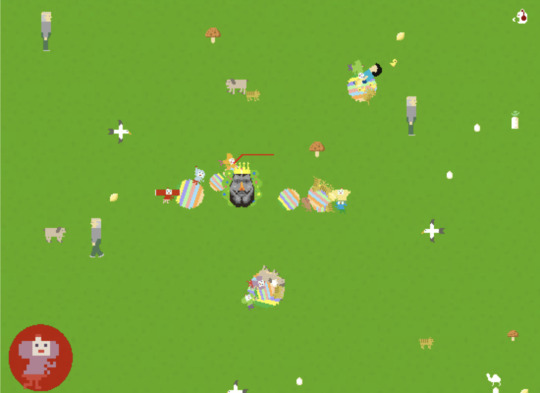
8-Bit Katamari Damacy was a browser game that, as the name suggests, utilized 8-bit graphics for it's visuals. Instead of playing as the Prince or one of the Cousins, you take control of The King of All Cosmos.

It's a simple little demake and thankfully, a few people have archived the game for posterity. While the gameplay is rudimentary,the the pixel art is quite charming. Check it out if you have a moment of free time.
In a future entry, I'll cover how these sprites would be reused for other games in the franchise. Surprisingly enough, The Prince of All Cosmos' sprite would also be used in Super Smash Bros. Ultimate.
---
Sources
8-Bit Katamari Damacy (Web Browser) sprites uploaded by StarmanElite (website: The Spriter's Resource) (section: Playable Characters)

#katamari damacy#katamari#keita takahashi#the prince of all cosmos#the king of all cosmos#browser games#pixel art#sprite art
4 notes
·
View notes
Text
Great news! I have uncovered another Cousin concept design!
About a year back, I was browsing the King’s Book when I found this lanky little Fujio with no facial hair! Look at him!

I uploaded it to Fujio’s page, thinking this would be the only early Cousin art available…
A year later, I am looking for a scan of Game Developer Magazine December 2004 (which is currently unavailable in full), which included a Katamari Damacy Postmortem. While I didn’t find a FULL scan, I did find two PDFs of the Katamari Damacy Postmortem and Uncanny Valley articles! And while reading the about the Uncanny Valley, look who I found!

The Katamari Damacy Postmortem included two new pieces of concept art.


The first image shows animal and human concept designs which heavily resemble some of the other concept art displayed at Keita Takahashi’s Zooming Out. The second image shows some detail on the houses in Katamari Damacy.
For more info on the archival of this magazine, please click below.
If you are interested in a text-only version of the Katamari Damacy Postmortem, it is viewable on Robin Hunicke’s blog archive here. (Please note that I do not support Robin Hunicke due to her workplace abuse allegations.)
Unfortunately, the GD magazine has not been archived in full, contrary to what the people behind Game Developer’s Conference Vault have stated. The current website is broken, but the PDFs of other issues are available to view here.
I have emailed GD, asking them to fix their website and to retrieve the issue, but they have yet to respond. If you own a copy or know someone who does, please upload it for preservation!

#katamari#katamari damacy#Katamari rarities#Fujio#shikao#concept art#keita takahashi#Lost media#game development
12 notes
·
View notes
Text
this isnt to a t
1 note
·
View note
